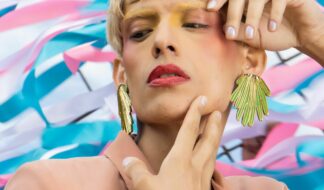By Carolyn Hayes
In its season selections, Two Muses Theatre has never hesitated to refer back to its mission to provide opportunities for women in theater. But in the company's fitting season closer, "Love, Loss, and What I Wore," it brandishes that missive like a flag. Director Diane Hill takes a play with all-female characters and viewpoints, and triples the cast – by closing night, no less than 15 women will have graced the Two Muses stage.
With a pictorial memoir by Ilene Beckerman as source material, playwright-adapters Nora Ephron and Delia Ephron expand on the story of "Gingy," a woman looking back on her life as a series of dresses and outfits – some made, some bought, some borrowed – that colored her most vital moments and experiences. Onstage, the woman playing Gingy is joined by four other actresses who trade off the narrative duties, diving briefly into other women's sartorial histories or joining together in service of familiar moments in fashion (what mothers say to daughters about their appearance, or the hated dressing-room experience, among others).
For the production's three-week run, Two Muses has recruited three local celebrities to headline as Gingy, and each is backed by a fresh quartet. The opening-night performance featured WOMC's Stacey DuFord, who, along with Yolanda Fleischer, Sonja Marquis, Amy Morrisey, and Susan Craves, will appear through Sunday, June 1. June 6-8 will star WXYZ host Lila Lazarus as well as Jan Cartwright, Julie Fuller, Wendy Hedstrom, and Courtney Burkett. And the final weekend (June 13-15) will see Fox 2 News anchor Anqunette Jamison and the ensemble of Connie Cowper, Julie Yolles, Kez Settle, and Rae McIntosh.
The play's multitude of characters, rich use of language, and tricky structural tics tend to preclude any attempt at dynamic staging; instead, the performers are planted in a row of stark white chairs, with binders before them, suggestive of a concert reading. Yet this static presentation by no means silences the design team. A simple but active lighting scheme by Lucy Meyo keeps pace with the shifting focal points, framing each woman precisely while simultaneously illuminating the subtly busy harmony of Bill Mandt's conceptual red, white and black scenic design. Costumer Barbie Weisserman emphasizes detailed accents and individuality in her take on not-so-basic black.
The collective effect is a statement that speaks to the show's own conceit: In the aggregate, these are women wearing black, seated before a red-and-white patterned background, telling a story about a memorable item of clothing. Up close, though, the results are as varied and multifaceted as women themselves.
By necessity, the performances are largely relegated to voice and face. The actresses frequently address the audience at large as though in an interview, opening up about topics as familiar as puberty and painful shoes, or as specific as surgical reconstruction after a mastectomy. Although the ensemble frequently lapses into conspicuously "character" voices for comic effect, the bigger stories are presented with far less affectation, and are more resonant for the choice.
By the same token, the over-the-top pantomime of pawing through one's closet garners some laughter, but doesn't bear the same weight as the simple gestures used to enhance the description of an item of clothing. Whereas Gingy's outfits are all accompanied by sweet line drawings as visual aids, coordinated by projection designer Hill, the ensemble's ensembles reside in the realm of imagination, and the loving spark of painting those mental pictures, wholly resurrecting those memories, ranks among the most honest and engaging of the cast's lively work. (Note that viewers closest to the stage will be best situated to appreciate this subtler work, so take that under advisement.)
There is a certain underlying homogeny to the script: An overwhelming proportion of the storytellers are New Yorkers (and their mothers invariably Noo Yawk-uhs), and the voices are strongly Ephron-esque, shot through with acid wit and charm familiar to fans of "When Harry Met Sally" or "Sleepless in Seattle." There's a safe sameness to the production as well, occupying a narrow, warm emotional ground that is careful never to get too sad or too angry.
But there's no denying the familiarity of this "Love, Loss, and What I Wore," which at its core is a relatable enterprise almost guaranteed to light up the memory receptors of the viewer's brain. Put simply, the camaraderie of a group of women spinning stories of fashion triumphs and tribulations is more than enough to sustain the play, which is designed to be felt and appreciated in just that spirit of communion. In fact, in the dim reflections of the stage lights, one may glimpse these women watching each other perform, smiling with fond recognition and appreciative commiseration.
REVIEW:
'Love, Loss, and What I Wore'
Two Muses Theatre at Barnes & Noble Booksellers, 6800 Orchard Lake Road, West Bloomfield. 8 p.m. Friday-Saturday and 2 p.m. Sunday through June 15. 90 minutes; no intermission. $17-20 in advance; $3 additional at the door. 248-850-9919. http://www.twomusestheatre.org









